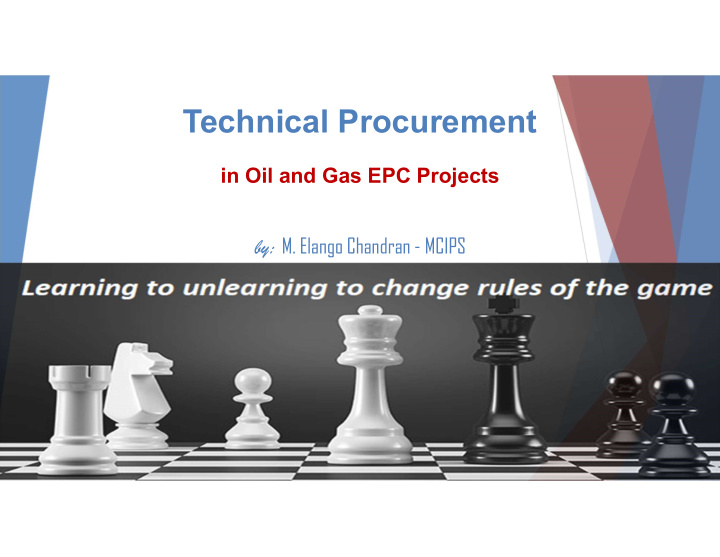



Technical Procurement in Oil and Gas EPC Projects by: M. Elango Chandran - MCIPS
Index Sl# Contents Introduction 1. Definition of Technical Procurement 2. Typical List of Technical Material and Services 3. Technical Procurement Process 4.
1. Introduction To understand EPC project procurement in oil and gas industry, we need to understand the concept and philosophy of project evolution. The oil industry is broken down into three segments: upstream, midstream, and downstream. Description Feasibility EPC Phase - 1 : FEED Phase – 2: FEED Detailed Procurement Construction O & M Engineering (operation Conceptual Pre- Light Normal Extended and Design FEED Maintenanc e Estimated +50 to +100 +15 to +10 to 20 +3 to 15 Accuracy 30 Duration 6 -12 months 8-16 months 8-10 months 10-12 months 12-14 months 1 or 2 years
2. Definition of Technical Procurement Materials and Services for which customized specifications and technical details have been arrived, on tailor-made basis by the selection of or development of equipment or materials that are suitable for its intended purpose, which are in accordance to codes, standards and process requirements for the project. These materials are also called Project permanent material and remains as an asset of the Client and must be procured as per Client specifications and approvals.
3. Typical List of Technical Material and Services Materials Mechanical Electrical Instrumentation Packages -Pressure Vessels -Distributed control system -Boilers -Switchgears -Tanks -Telecom system -Air Handling Units -Transformers -Pumps -Supervisory control and data -Water Treatment Plants -Motors acquisition system -Compressors -Solar Power Systems -Metering Skids, -Security Systems -Turbines -Separators -Emergency Power Generators -Meters/ Analyzers -Piping and Values, etc... -Fire Fighting system, etc.. -Power Cable, etc.. -FOC and Instrument cables, etc.. Services Mechanical Electrical and Instrumentation Civil Specialist Subcontracts -Painting and Coating -Topographic survey -Detail Engineering -Cathodic Protection -Fire Proofing -Geotechnical Investigation -Over Headline Lines works -Health, Safety and Environmental Impact -Insulation -Soil Improvement -Cable Jointing and Termination Assessment Study works -Non-Destructive testing -Earth works -Third Party Inspection -Electrical Heat Tracing -Heavy Lifts -Structural works -Non-Destructive Road Crossing -VSAT / Telecommunication -Prefabricated Building -Building works -Caliper survey. -Instruments Calibration and Testing -Field Erected Tank -Road works -Commissioning services etc.. -Automatic Welding, etc.. -Marine Works, etc.. -HVAC works, etc..
4. Procurement Process for Technical Material and Services ENGINEERING Technical Technical Bid Participation VDDR Issuance of Evaluation Purchase Request Evaluation (*) in KOM (*) Approval (*) MR/ SOW (*) & SEPQ (*) PROCUREMENT Pre-Order Award Order Issuance of Receipt of Coordinate for TQ Commercial Vendor Kick Recommendation Negotiations Issuance RFQ Offer closeout Evaluation Off Meeting (*) Mfg. Post-Order Inspection Material Port Clearance Arrange for Issuance of VDDR Progress Notification Shipment / Warehousing Receipt on and Inland Dispatch Monitoring & Submission Logistics Site Transportation Note (*) Expediting QA/QC Issuance of Receiving Inspection Depute QA/QC Inspection Inspection Release Inspector Test Plan at Site(*) Note Third Party Inspection Issuance of Depute Third Party Inspection * client to be notified and Involvement or Approval Required in these stages Inspector Report
Q & A Q1: At which stage of technical procurement process, the product optimization is achieved? a: Technical Evaluation b: technical bid evaluation c: Award recommendation A1: b: technical bid evaluation Q2: At which stage of technical procurement process, the price optimization is achieved? a: Technical Evaluation b: Commercial Evaluation c: Award recommendation A2: c: Award recommendation Q3: An order is issued not based on …. a: award recommendation b. Purchase requisition c. Material requisition Q3: c: Material requisition
Agile approaches to procurement is speeds up the process and lowers risk Agile procurement is a way of purchasing solutions according to the outcomes you seek, rather than a product specification. It’s about being flexible, you don’t begin by looking for a particular solution, but rather discuss your needs with potential vendors and subcontractors and become aware of what solutions exist. With agile approach comes innovation . Unless you have been through a procurement process multiple times before, it is difficult to know exactly what you are looking for. Agile allows you to move away from full-scoped project details, and instead explain your problem and let the vendors and subcontractors do the rest. You run the project, not the vendor: For Agile to succeed you need to drive the project. The vendors and subcontractors may take on the lion’s share of project management and development, but is your responsibility to ensure that your business challenges are being addressed. Understanding the vision for your agency, and ensuring this is kept at the centre of the project at all times, is the only way to make sure the final result will meet your needs. Vendor relationships: Agile contracts do not define what solution you are purchasing, they define the expectations of a relationship between you and the vendor. You need to be clear here on what you expect in terms of performance, and also the role of your representatives, as vendors may need access to people who are able to make quick decisions. Responding to change rather than following a plan: Agile procurement is outcomes based it offers much more flexibility than requirements-driven procurement, meaning that projects can be adjusted as new needs are discovered. Having the option to respond to these changes results in much more successful outcomes for procurement organization. Overall the benefits of an Agile approach are huge: better, more targeted solutions that solve the intended problems whilst enabling a smooth vendor-client relationship.
Recommend
More recommend